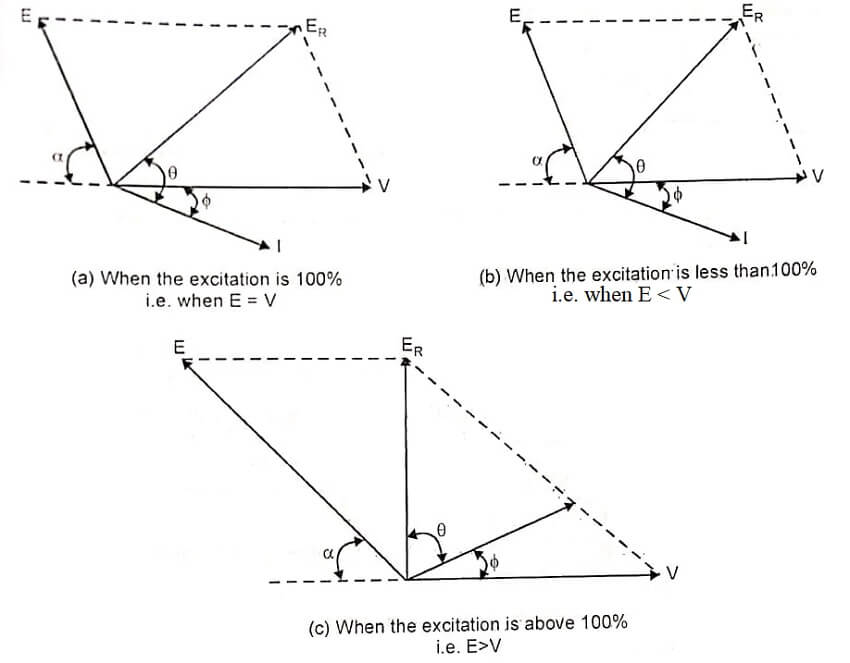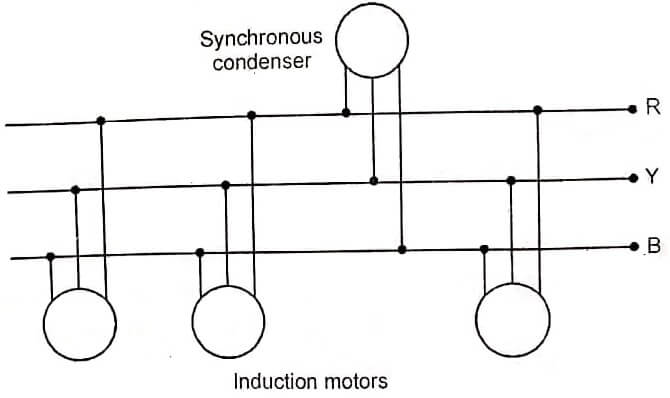If the excitation of a synchronous motor is kept constant, the load current changes with the variation of load. If the load is kept constant and field excitation is varied, the synchronous motor operates by changing its power factor.
When the excitation is weak. the stator takes a magnetising current from 3 phase AC supply mains to help the DC field. This magnetising component lags behind the applied voltage by 90°. The magnetising component is a large part of the total current input and therefore, results in a low lagging power factor. For constant applied voltage and constant input per phase active component of current drawn from the supply mains should be constant and because of large magnetising current armature current I is much more.
When the excitation is increased to 100% the magnetising current drawn from 3 phase AC supply is reduced. Thus, the magnetising component of current becomes a smaller part of total input current to the stator winding and the power factor improves. This results in reduction of armature current, I drawn from 3 phase AC supply mains.
When the excitation is further increased such that power factor becomes unity, the stator draws only energy or active current and the DC field current supplies all the current necessary to magnetise the rotor field. When the power factor, cosΦ is unity the armature current I, drawn will be minimum.
If the excitation is further increased, the rotor field becomes over strong and the stator draws demagnetising current to make the rotor field weaker. Since the demagnetising component leads the applied voltage by 90°, the demagnetising component of current makes the power factor leading but lesser than unity and consequently the armature current increases.
Consider a synchronous motor loaded with a constant mechanical load and 100% excitation i.e., having induced e.m.f per phase E equal to applied voltage per phase V in magnitude. Let it take a current of I amperes lagging behind the applied voltage V by an angle. The power drawn per phase from the 3 phase AC supply mains is VI cosΦ.
Since applied voltage and input power or load is constant, active component of current drawn from supply mains, I cosΦ is constant for constant mechanical load. As the speed remains constant incase of a synchronous motor so increase in excitation results in increase in induced e.m.f and decrease in excitation in reduced of induced e.m.f.
When the excitation is reduced the induced e.m.f decreases in magnitude to the value shown in figure (b) which shifts the resultant voltage ER in clockwise direction and since the phase angle Φ between the resultant voltage ER and current I being equal to tan−1 Xs/Ra is constant, vector current I is also shifted in clockwise direction.
Therefore phase angle Φ between supply voltage V and current I increase. Due to increase of phase angle Φ the power factor cosΦ decreases and current I increases since I cosΦ is constant. Hence with reduction in excitation synchronous motor draws more current from the supply mains at lower power factor.

If excitation is increased, the induced e.m.f increases in magnitude to a value shown in figure (c) which shifts the resultant voltage ER. in counter clockwise direction. This results in change in phase position of the current I with respect to terminal voltage V so that the motor then operates at a leading power factor.
For a certain value of excitation phase angle Φ between voltage V and current I is zero, the current I will be inphase with voltage V and at this instant the value of current drawn from supply mains, I will be minimum. If the excitation is further increased it takes current with leading power factor as shown in figure (c).
Hence when the excitation of a synchronous motor is increased above 100%, first power factor improves until it becomes unity; at this instant the current drawn from the supply mains is minimum and in phase with supply voltage. With further increase in field current the power factor becomes leading one and decreases and current drawn from supply main increases.
Advantages of Synchronous Motors
- The speed is constant and independent of load.
- These motors usually operate at higher efficiencies.
- Electro magnetic power varies linearly with the voltage.
- These motors can be constructed with wider air gaps than induction motors, which make them better mechanically.
- An over excited synchronous motor having a leading power factor can be operated in parallel with induction motors.
Disadvantages of Synchronous Moto
- It cannot be started under load.
- It requires dc excitation which must be supplied from external source.
- It has a tendency to hunt.
- It cannot be used for variable speed jobs as there is no possibility of speed adjustment.
- Collector rings and brushes are required.
Application of Synchronous Motors
- They are used in power houses and substations in parallel to the bus-bars to improve the power factor.
- Synchronous motors are also used to regulate the voltage at the end of transmission lines.
- In factories having a large number of induction motors, or other power. apparatus operating at lagging power, they are employed to improve the power factor.
- Typical applications of high speed synchronous motors are such drives as fans, blowers, de generators, line shafts, centrifugal pumps and compressors, reciprocating pumps and constant speed frequency changers, rubber and paper mills etc.
Hunting and Methods of Suppression
- When a synchronous motor is used for driving a varying load, then a condition known as hunting occurs.
- Hunting is an objectionable characteristic of all synchronous motor, since it produces severe mechanical stresses as well as great variation in current and power taken by the motor.
- When a synchronous motor is loaded, it rotor falls back in phase by the coupling angle δ.
- As the load is progressively increased, this angle also increases so as to produce more torque to carry the increased load.
- If there is sudden decrease in load, the motor is immediately pulled up or advanced to a new value of δ corresponding to the new load.
- But in this process, the motor overshoots and hence is again pulled back.
- In this way, the rotor starts oscillating about its new position of equilibrium corresponding to the new load.
- If the time period of these oscillations happens to be equal to the natural time period of the machine, then mechanical resonance is set up.
- To stop the build up of these oscillations dampers or damper windings or amortisseur windings are employed.
- These dampers consist of short circuited copper bars embedded in the faces of the field poles of the rotor.
- The oscillatory motion of rotor sets up eddy currents in the dampers which flow in such a way as to suppress the oscillations.
Synchronous Condenser
An over excited synchronous motor running on ho load is known as synchronous capacitor or synchronous condenser.
A synchronous motor takes a leading current when over excited and therefore, behaves as a capacitor. When such a machine is connected in parallel with induction motor or other devices that operate at lagging power factor, the leading kVAR supplied by the synchronous capacitor partially neutralises the lagging reactive kVAR of the loads.
Consequently, power factor of the system is improved. It is shown in figure. Synchronous capacitors (unloaded over-excited synchronous motors) are installed in substations solely for power factor improvement. They are economical in large sizes that the static capacitors.

[sc_fs_faq html=”true” headline=”h2″ img=”” question=”When does a synchronous motor get over excited?” img_alt=”” css_class=””] If the field excitation of the motor is increased, the field flux will become strong and Eb will increase. As a result Eb will exceed V and the motor will be called an over excited motor. [/sc_fs_faq]
| Read More Topics |
| Types of torque in synchronous motor |
| V curves and inverted V curves |
| Horizontal axis wind turbine advantages and disadvantages |





